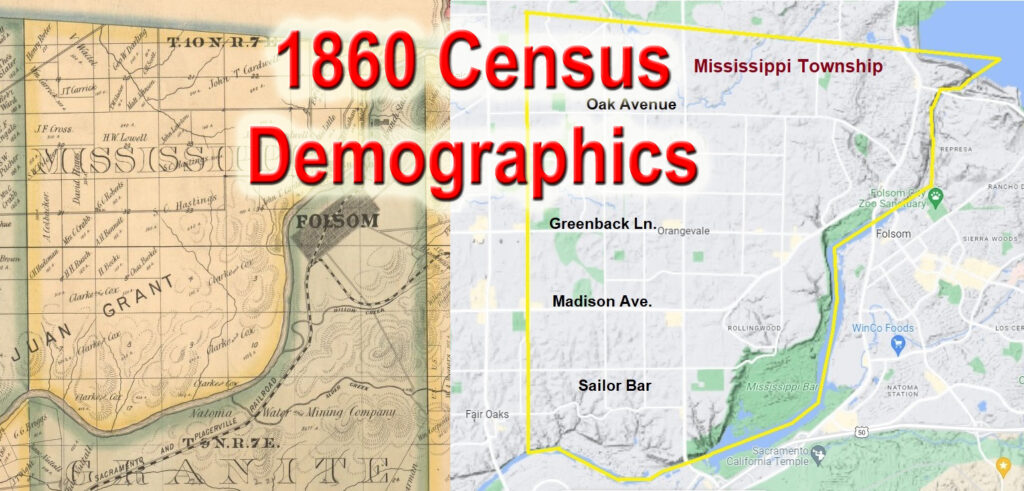Long before Fair Oaks, Orangevale and Cardwell colonies were developed, Mississippi Township in northeast Sacramento County was dominated by the San Juan land grant. In 1860, Mississippi Township, encompassing approximately 25 square miles, was populated mainly by foreign-born residents. Most men were engaged in mining activities. Chinese men made up the majority or miners in the township.
1860 Census Mississippi Township, Sacramento County
By 1860, Mississippi Township could boast of miles of water canals and a railroad. While the California Central Railroad would cease to exist by 1868, the water system of the North Fork Ditch would continue for decades. The water, diverted by a dam on the North of the American River below Auburn, would serve miners and an emerging agricultural economy. However, in 1860, mining was the dominant industry in the township north of the American River and south of Placer County.
Even though most of the land in Mississippi Township was held by the owners of the San Juan land grant, it did not preclude the development of water canals through the township. In 1857, Amos Catlin purchased a 1/5 interest in the San Juan land grant. Catlin organized the American River Water and Mining Company that built the North Fork Ditch. Catlin’s ownership in the land grant helped facilitate extending the North Fork Ditch water system into Mississippi Township. In lieu of a fixed monthly rent for the water canals over the land, the North Fork Ditch company paid the San Juan grant owners a 20 commission on the sale of the water.
Population by Birth in 1860
Most of the population in the Mississippi Township in 1860 lived along or near the American River. The principal post office was Folsom. Ashland (Russville), across the river from the town of Folsom, hosted some merchants and briefly the Sacramento, Placer, & Nevada Railroad depot. While the water provided by the North Fork Ditch was helping develop an agricultural base, mining was the dominant occupation.
The 1860 census for Mississippi Township is enumerated on 8 pages. There were 93 residential dwellings in the township housing 320 individuals. Of the residents in 1860, 40 percent were born in the United States, 29 percent had a European birth, and 30 percent had immigrated from China. As would be expected in a California mining region of 1860, 82 percent of the residents were male.
Of the 92 European born residents, 44 percent listed Ireland as their country of birth. Other European residents came from Germany, England, and Scotland.
For those 128 residents born in another state, New York and Missouri represented the most adults with 15 and 14 percent respectively. California born residents comprised 25 percent of U.S. born residents in 1860 Mississippi Township. The 32 California born children were under the age of 8. This meant that U.S. born adults were the minority in the township in 1860.
Within the 1860 census, 236 residents listed an occupation. Miner was listed by 151 men or 64 percent of the occupations recorded. There was the collection of butchers, blacksmiths, cooks, and clerks. Laborer was listed by 19 men and 20 men identified as farmer or gardener. Stone cutter, listed by 8 men, was a result of the small industry of cutting granite. Of the 7 merchants, 5 were recognized as Chinese men, most likely along Mississippi Bar catering to the Chinese miners. The township had 2 toll bridges (Mississippi Bar and Folsom) which necessitated the toll keeper occupation.
Mississippi Occupations, Mining Number One
Very few of the U.S. born residents in Mississippi Township were engaged in mining in 1860. Most of the miners were either from Europe (28%) or China (58%.) The mining claims within Mississippi Township, along the river, were not particularly profitable. Most of the placer gold was to the south of the American River. However, with the water from the North Fork Ditch, some men were able to squeeze out enough gold to live. There are reports of Chinese miners working along Mississippi Bar into the late 19th century.
It was the mining and emerging agricultural sector that kept the North Fork Ditch water system running. The system of water canals, flumes, and wooden pipes could easily have been abandoned if it were not for the modest demand for water for mining purposes. Later in the 19th century, the Fair Oaks, Orangevale, and Cardwell colonies would start requesting North Fork Ditch water for their developments.
Chinese Contribution: Sustaining Water System
The Chinese presence in Mississippi Township has all but evaporated with few clues of its existence. One of their legacies is supporting the North Fork Ditch by buying water for mining and working for the North Fork Ditch on maintenance and repair projects. The water system of 1860 was enhanced and transformed to supply water for the growing suburban development of the 20th century in northeast Sacramento County.
